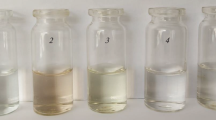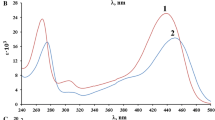Abstract
The acid–base properties of 2-thiobarbituric, 1,3-diethyl-, and 1,3-dibutyl-2-thiobarbiturc acids and the thermodynamics of their complexation with Ag(I) ions in aqueous solutions have been investigated using a spectrophotometric technique and ab initio calculations. The free acids primarily exist in keto-form and undergo enolization in neutral aqueous solutions. They undergo protonation via free oxygen atoms in acidic conditions. It has been discovered that 1,3-diethyl-2-thiobarbiturc acid behaves as a S-donor ligand under these conditions. The TD–DFT calculations of all the thiobarbiturc acids have revealed π–π* transitions from the sulfur and oxygen atoms in the ring. The complexation with Ag(I) ions lead to the transition of the z2 orbital of silver and π orbitals of sulfur into π* orbitals of a ring.







Similar content being viewed by others
References
da Marisco, C.M., Ribeiro, C.P., Bonini, J.S.: Ammonia potentiates methylmalonic acid-induced convulsions and TBARS production. Exp. Neurol. 182, 455–460 (2003)
Farias, I.L., Farias, J.G., Rossato, L., Araújo, M.C., Chiesa, J.: Correlation between TBARS levels and glycolytic enzymes: the importance to the initial evaluation of clinical outcome of colorectal cancer patients. Biomed. Pharmacother. 65, 395–400 (2011)
Hoda, A.A., Mostafa, I.E., Laila, A.R.: Thiobarbituric acid reactive substance (TBARS) a marker of oxidative stress in obstructive sleep apnea. Egypt. J. Chest Dis. Tuberc. 63, 119–124 (2014)
Barc, S., Stadelmann, S.I.: Effect of ischemia on TBARS and lactate production in several cerebral regions of anaesthetised and awake rats. Life Sci. 74, 3103–3113 (2004)
Ezzaher, A., Mouhamed, D.H., Mechri, A.: TBARs and non-enzymatic antioxidant parameters in Tunisian bipolar I patients. Immuno-Anal. Biol. Spéc. 27, 315–324 (2012)
Diaz, P., Linares, M.B., Egea, M., Linares, M.B.: Egea, M.: TBARs distillation method: Revision to minimize the interference from yellow pigments in meat products. Meat Sci. 98, 569–573 (2014)
Nowak, D., Katucka, S., Biatasiewicz, P.: Exhalation of H2O2 and thiobarbituric acid reactive substances (TBARs) by healthy subjects. Free Radic. Biol. Med. 30, 178–186 (2011)
Papastergiadis, A., Mubiru, E., Van Langenhove, H.: Malondialdehyde measurement in oxidized foods: evaluation of the spectrophotometric thiobarbituric acid reactive substances (TBARS) test in various foods. J. Agric. Food Chem. 60, 9589–9594 (2012)
de Azevedo, G., da Silva, E., Nascimento, M.R.: Evaluation of the 2-thiobarbituric acid method for the measurement of lipid oxidation in mechanically deboned gamma irradiated chicken meat. Food Chem. 80, 433–437 (2003)
Guillén-Sans, R.M., Guzmán-Chozas, N.: The thiobarbituric acid (TBA) reaction in foods: a review. Crit. Rev. Food Sci. Nutr. 38, 315–330 (1998)
Faidallah, H.M., Khan, K.A.: Synthesis and biological evaluation of new barbituric and thiobarbituric acid fluoro analogs of benzenesulfonamides as antidiabetic and antibacterial agents. J. Fluor. Chem. 142, 96–104 (2012)
Liang, M., Li, S., Zheng, H.: Synthesis and biological activity of novel barbituric and thiobarbituric acid derivatives against non-alcoholic fatty liver disease. Eur. J. Med. Chem. 46, 2003–2010 (2011)
Bloom, R.J., Westerfeld, W.W.: The thiobarbituric acid reaction in relation to fatty livers. Arch. Biochem. Biophys. 145, 669–675 (1971)
Suda, I., Furuta, S., Nishiba, Y.: Fluorometric determination of a 1,3-diethyl-2-thiobarbituric malondialdehyde adduct as an index of lipid peroxidation in plant. Biotechnol. Biochem. 58, 14–17 (1994)
Tabassum, S., Siddiqi, K.S., Khan, N.H., Kureshy, R.I.: Studies on complexes of thiobarbituric and 5,5-diethylbarbituric acid with lanthanide ions. Ind. J. Chem. 26, 489–495 (1987)
Moamen, S.R., El-Korashy, S.A., Ahmed, A.S.: A convenient method for the preparation of barbituric and thiobarbituric acid transition metal complexes. Spectrochim. Acta Part A 71, 1084–1094 (2008)
Masoud, M.S., El-Dessouky, M.A.: Transition metal (disubstitutedphenylazo)-barbituric and thiobarbituric acid complexes. Trans. Met. Chem. 15, 443–448 (1990)
Li, X., Wu, D., Gu, Y., Gan, F.: Synthesis, spectral and thermal properties of some transition metal(II) complexes with a novel ligand derived from thiobarbituric acid. Therm. Anal. Calorim. 98, 387–394 (2009)
Murphy, R.J., Svehla, G.: An analytical study of metal–thiobarbituric acid complexes. Anal. Chim. Acta 99, 115–124 (1978)
Balas, R., Verginadis, S., Geromichalos, G., Kourkoumelis, N., Male, L.: Synthesis, structural characterization and biological studies of the triphenyltin(IV) complex with 2-thiobarbituric acid. Eur. J. Med. Chem. 46, 2835–2844 (2011)
Zambrzycka, E., Godlewska-Zytkiewicz, B.: A new ion imprinted polymer based on Ru(III)–thiobarbituric acid complex for solid phase extraction of ruthenium(III) prior to its determination by ETAAS. Microchim. Acta 181, 1019–1027 (2005)
Golovnev, N.N., Molokeev, M.S., Vereshchagin, S.N.: The cis–trans isomer transformation, spectroscopic and thermal properties of Li, Na, K 1,3-diethyl-2-thiobarbiturate complexes. Polyhedron 85, 493–498 (2015)
Golovnev, N.N., Molokeev, M.S., Golovneva, I.: The crystal structure of lead(II) 1,3-diethyl-2-thiobarbiturate. Russ. J. Coord. Chem. 41, 300–304 (2015)
Loginovaa, N.V., Chernyavskayaa, G.I., Polozova, T.V.: Silver(I) interaction and complexation with sterically hindered sulfur-containing diphenol derivatives. Polyhedron 24, 611–618 (2005)
Lansdown, A.B.: A pharmacological and toxicological profile of silver as an antimicrobial agent in medical devices. Adv. Pharm. Sci. 2010, 1–16 (2010)
Eliseeva, S.V., Bunzli, J.-C.G.: Rare earths: jewels for functional materials of the future. New J. Chem. 35, 1165–1176 (2011)
Valiev, M., Bylaska, E.J., Govind, N., Kowalski, K., Straatsma, T.P.: NWChem: a comprehensive and scalable open-source solution for large scale molecular simulations. Comput. Phys. Commun. 181, 1477–1489 (2010)
http://www.cluster.sfu-kras.ru (accessed April 1, 2015)
Adamo, C., Barone, V.: Toward reliable density functional methods without adjustable parameters: the PBE0 model. J. Chem. Phys. 110, 6158–6170 (1999)
Dunning Jr., T.H.: Gaussian basis sets for use in correlated molecular calculations. I. The atoms boron through neon and hydrogen. J. Chem. Phys. 90, 1007–1023 (1989)
Peterson, K.A., Puzzarini, C.: Systematically convergent basis sets for transition metals. II. Pseudopotential-based correlation consistent basis sets for the group 11 (Cu, Ag, Au) and 12 (Zn, Cd, Hg) elements. Theor. Chem. Acc. 114, 283–296 (2005)
Marenich, A.V., Cramer, C.J., Truhlar, D.G.: Universal solvation model based on solute electron density and on a continuum model of the solvent defined by the bulk dielectric constant and atomic surface tensions. J. Phys. Chem. B 113, 6378–6396 (2009)
Zhurko, G.A.: ChemCraft, version 1.7. http://www.chemcraftprog.com (accessed March 1, 2015)
Leggett, D.J.: Computational Methods for the Determination of Formation Constants. Plenum Press, New York (1985)
Tiwari, S., Ghosh, K.K.: Mixed micellization properties of cationic monomeric and gemini surfactants. J. Chem. Eng. Data 55, 4162–4167 (2010)
Cox, R.: Acidity functions: an update. Can. J. Chem. 61, 2225–2229 (1983)
Cox, R.: The excess acidity of aqueous HCl and HBr media. An improved method for the calculation of X-functions and H. Can. J. Chem. 59, 2023–2028 (1981)
Celik, H., Büyükaga, M.: Determination of pK a values of some benzoxazoline derivatives and the structure–activity relationship. J. Chem. Eng. Data 58, 1589–1596 (2013)
http://www.scilab.org/ (accessed July 1, 2015)
Grebenyuk, S.A., Perepichka, I.F., Popov, A.F.: Evaluation of the parameters of 1:1 charge transfer complexes from spectrophotometric data by non-linear numerical method. Spectrochim. Acta Part A 58, 2913–2923 (2002)
Mendez, E., Cerda, M.F., Gancheff, J.S.: Tautomeric forms of 2-thiobarbituric acid as studied in the solid, in polar solutions, and on gold nanoparticles. J. Phys. Chem. C 111, 3369–3383 (2007)
TellezSoto, C.A., Ramos, J.M., Junior, A.C.: Surface enhancement Raman scattering of tautomericthiobarbituric acid: natural bond orbitals and B3LYP/6311+G(d, p) assignments of the Fourier infrared and Fourier Raman spectra. Spectrochim. Acta A 114, 475–485 (2013)
Petrov, A.I., Lutoshkin, M.A., Taydakov, I.V.: Aqueous complexation of Y(III), La(III), Nd(III), Sm(III), Eu(III), and Yb(III) with some heterocyclic substituted β-diketones. Eur. J. Inorg. Chem. 6, 1074–1082 (2015)
Street, H.V., McMartin, C.: Action of concentrated sulphuric acid on 5,5-disubstituted barbituric acid derivatives. Clin. Chim. Actu. 9, 301–308 (1964)
Maynert, E.W., Washbur, E.: Reactions of barbituric acids in sulfuric acid. J. Am. Chem. Soc. 75, 700–704 (1953)
Singh, B.R., Jain, R.K., Jain, M.K., Ghosh, R.: Thermodynamics of the interaction of some transition metal ions with some N-substituted thiobarbituric acids. Thermochim. Acta 78, 175–180 (1984)
Smyth, W.F., Svehla, G., Zuman, P.: Polarographic and spectral investigation of acid–base equilibria in aqueous solutions of 2-thiobarbituric acids with substituents on sulphur. Anal. Chim. Acta 52, 129–138 (1970)
Izquerdo, A., Beltran, J., Guitras, L.: Thermodynamic properties of the dissociation of 2-mercaptopyridine, 2-mercaptopyrimidine and 2-thiobarbituric acid. Thermochim. Acta 127, 81–88 (1988)
Blais, M.S., Enea, O., Berthon, G.: Relations structure–réactivité grandeurs thermodynamiques de protonation geterocycles saturés et non saturés. Thermochim. Acta 20, 335–338 (1977)
Sansand, R.G., Chozas, M.G.: Spectrophotometric evaluation of ionization constants of some arylidene thiobarbituric acids. Microchem. J. 37, 40–50 (1988)
Cox, R.A., Clinton, R.S., Yates, K.: The excess acidity method. The basicities, and rates and mechanisms of enolization, of some acetoghenones and acetone, in moderately concentrated sulfuric acid. Can. J. Chem. 57, 2952–2959 (1979)
Burgot, J.-L.: Ionic Equilibria in Analytical Chemistry, pp. 452–458. Springer, Dordrecht (2012)
Blais, M.-J., Berthon, G.: Formation constants for complexes of silver with some heterocyclic ligands containing nitrogen and sulphur as donor atoms. J. Inorg. Nucl. Chem. 41, 933–935 (1979)
Golovnev, N.N., Molokeev, M.S., Lutoshkin, M.A.: Crystal structure of catena-(μ4-1,3-diethyl-2-thiobarbiturato-O, O′, S, S′) silver(I). Russ. J. Inorg. Chem. 60, 572–576 (2015)
Crugeiras, J., Ríos, A., Maskill, H.J.: DFT and AIM Study of the protonation of nitrous acid and the pK a of nitrous acidium ion. J. Phys. Chem. 115, 12357–12363 (2011)
Bryantsev, V.S., Mamadou, S.D., Goddard III, W.A.: Calculation of solvation free energies of charged solutes using mixed cluster/continuum models. J. Phys. Chem. B. 112, 9709–9719 (2008)
Vukovic, S., Hay, B.P., Bryantsev, V.S.: Predicting stability constants for uranyl complexes using density functional theory. Theor. Inorg. Chem. 54, 3995–4001 (2015)
Kumari, P., Chandran, P., Sudheer, K.S.: Synthesis and characterization of silver sulfide nanoparticles for photocatalytic and antimicrobial applications. J. Photochem. Photobiol. B 141, 235–240 (2014)
Acknowledgments
The research has been funded and carried out in terms of state contract (No. 3049) of Ministry of Education and Science of Russian Federation. The authors would also like to thank SFU CEJU for technical support.
Author information
Authors and Affiliations
Corresponding author
Electronic supplementary material
Below is the link to the electronic supplementary material.
Rights and permissions
About this article
Cite this article
Lutoshkin, M.A., Petrov, A.I. & Golovnev, N.N. Acid–Base, Complexing and Spectral Properties of Thiobarbituric Acid and Its 1,3-Derivatives in Aqueous Solutions: Spectrophotometric and Quantum Chemical Approach. J Solution Chem 45, 1453–1467 (2016). https://doi.org/10.1007/s10953-016-0525-3
Received:
Accepted:
Published:
Issue Date:
DOI: https://doi.org/10.1007/s10953-016-0525-3




